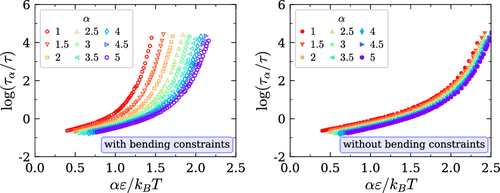当前位置:
X-MOL 学术
›
Macromolecules
›
论文详情
Our official English website, www.x-mol.net, welcomes your feedback! (Note: you will need to create a separate account there.)
Role of Cohesive Energy in Glass Formation of Polymers with and without Bending Constraints
Macromolecules ( IF 5.5 ) Pub Date : 2020-11-11 , DOI: 10.1021/acs.macromol.0c01876 Wen-Sheng Xu 1 , Jack F. Douglas 2 , Xiaolei Xu 1
Macromolecules ( IF 5.5 ) Pub Date : 2020-11-11 , DOI: 10.1021/acs.macromol.0c01876 Wen-Sheng Xu 1 , Jack F. Douglas 2 , Xiaolei Xu 1
Affiliation

|
The influence of the monomer chemical structure and architecture on polymer glass formation has been long appreciated to be dominated by two principal molecular factors, namely, cohesive energy and chain stiffness. Here, we utilize molecular dynamics simulation, along with the analytic generalized entropy theory (GET), to compare and contrast the role of cohesive energy in determining the thermodynamic and dynamic properties of polymer melts with and without bending constraints at zero pressure. As a general finding, our simulation results support the predictions of the GET that the temperature dependence of basic thermodynamic properties, such as the reduced thermal expansion coefficient and isothermal compressibility, becomes universal when the temperature is scaled by the cohesive energy parameter regardless of the bending constraints. Our simulation results confirm that dramatic changes in the temperature dependence of the structural relaxation time and extent of cooperative motion caused by cohesive interaction strength can likewise be eliminated largely using the same scaled temperature in polymer melts without bending constraints, but this simple picture does not emerge when bending constraints are introduced, a result in general accord with the predictions of the GET. Moreover, the fine features predicted by the GET, which are associated with the nonlinear growth of characteristic temperatures and the reduction of fragility with increasing cohesive interaction strength, are also confirmed by our simulations for polymer melts with bending constraints. Going beyond the validation of the predictions of the GET, we show that our simulation results for the structural relaxation time and extent of cooperative motion conform to the string model of glass formation in both polymer melts with and without bending constraints having variable cohesive interaction strength. We then utilize the string model to understand phenomenological models of structural relaxation of recent interest in glass-forming liquids. The string model also allows us to examine the dependence of the enthalpy and entropy of the high-temperature activation free energy on cohesive interaction strength. We emphasize the role of the activation entropy in improving the quantitative predictive capacity of the GET.
中文翻译:

内聚能在有和没有弯曲约束的聚合物玻璃形成中的作用
长期以来,人们一直认为单体化学结构和结构对聚合物玻璃形成的影响主要受两个主要分子因素的影响,即内聚能和链刚度。在这里,我们利用分子动力学模拟以及解析广义熵理论(GET),比较和对比内聚能在确定零压力下有无弯曲约束的聚合物熔体的热力学和动力学性质中的作用。总的来说,我们的模拟结果支持GET的预测,即当温度通过内聚能参数缩放时,无论弯曲如何,基本热力学特性的温度依赖性(例如降低的热膨胀系数和等温可压缩性)将变得普遍。约束。我们的模拟结果证实,使用相同比例的温度在聚合物熔体中没有弯曲约束的情况下,同样可以很大程度上消除结构弛豫时间与温度之间的剧烈变化以及内聚相互作用强度引起的协同运动程度,但是这种简单的图景并未出现当引入弯曲约束时,结果通常与GET的预测一致。此外,通过我们对具有弯曲约束条件的聚合物熔体的模拟也证实了GET预测的优良特征,这些优良特征与特征温度的非线性增长以及随着内聚相互作用强度的增加而降低的脆性有关。除了验证GET的预测之外,我们表明,我们的结构弛豫时间和协同运动程度的模拟结果符合在有和没有弯曲约束且具有可变内聚相互作用强度的两种聚合物熔体中玻璃形成的弦模型。然后,我们利用字符串模型来理解最近对玻璃形成液体感兴趣的结构松弛现象学模型。串模型还允许我们检查高温活化自由能的焓和熵对内聚相互作用强度的依赖性。我们强调激活熵在提高GET的定量预测能力中的作用。
更新日期:2020-11-25
中文翻译:

内聚能在有和没有弯曲约束的聚合物玻璃形成中的作用
长期以来,人们一直认为单体化学结构和结构对聚合物玻璃形成的影响主要受两个主要分子因素的影响,即内聚能和链刚度。在这里,我们利用分子动力学模拟以及解析广义熵理论(GET),比较和对比内聚能在确定零压力下有无弯曲约束的聚合物熔体的热力学和动力学性质中的作用。总的来说,我们的模拟结果支持GET的预测,即当温度通过内聚能参数缩放时,无论弯曲如何,基本热力学特性的温度依赖性(例如降低的热膨胀系数和等温可压缩性)将变得普遍。约束。我们的模拟结果证实,使用相同比例的温度在聚合物熔体中没有弯曲约束的情况下,同样可以很大程度上消除结构弛豫时间与温度之间的剧烈变化以及内聚相互作用强度引起的协同运动程度,但是这种简单的图景并未出现当引入弯曲约束时,结果通常与GET的预测一致。此外,通过我们对具有弯曲约束条件的聚合物熔体的模拟也证实了GET预测的优良特征,这些优良特征与特征温度的非线性增长以及随着内聚相互作用强度的增加而降低的脆性有关。除了验证GET的预测之外,我们表明,我们的结构弛豫时间和协同运动程度的模拟结果符合在有和没有弯曲约束且具有可变内聚相互作用强度的两种聚合物熔体中玻璃形成的弦模型。然后,我们利用字符串模型来理解最近对玻璃形成液体感兴趣的结构松弛现象学模型。串模型还允许我们检查高温活化自由能的焓和熵对内聚相互作用强度的依赖性。我们强调激活熵在提高GET的定量预测能力中的作用。



























 京公网安备 11010802027423号
京公网安备 11010802027423号